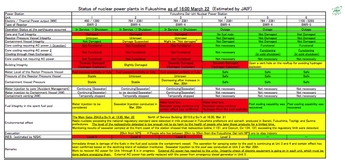Work to restore electricity at Fukushima-Daiichi was halted yesterday when white vapor (steam or smoke) was seen rising from the top of units 2 and 3.

Workers were evacuated as a precaution, although according to TEPCO parameters relating to the unit 3 reactor pressure vessel, reactor containment vessel, and monitored environmental data remained constant. As of Tuesday morning, the white vapor from unit 2 lessened, and the grey vapour from unit 3 turned white, which TEPCO interprets as a favourable indication.
As a result power connection work now continues, with hopes of providing power to units 2 and 4 today, according to the Japan Atomic Industrial Forum.
Also, JAIF reported that the Tokyo fire department and Osaka fire department continued to spray water on the unit 3 fuel pool today. Reactor spent fuel pools are outside of containment and are near boiling point. If sufficient water boils away, exposing the fuel, radioactivity could be released.
Radioisotopes were detected in the seawater around the unit 1-4 discharge canal on 21 March. Levels of iodine-131, caesium-134 and caesium-137 were 127, 25 and 17 times legal limits, respectively. In addition, levels of cobalt-58, iodine-132 and caesium-136 were detected, but below legal levels.
Site staff have been using seawater to cool the reactor cores of units 1, 2, 3 and 4 as an emergency measure.
An additional sampling programme is scheduled for 22 March around the Daiichi coastal sea area, and at the Daini coastal area, to examine the extent of diffusion.
FilesReactor-by-reactor, system-by-system summary from JAIF on 23 March




